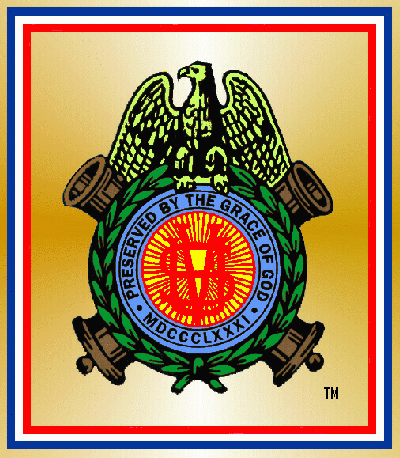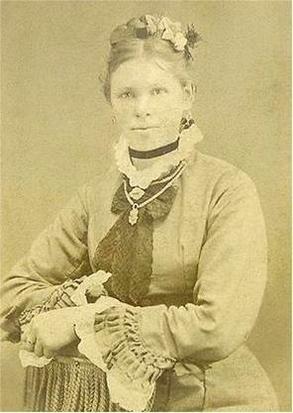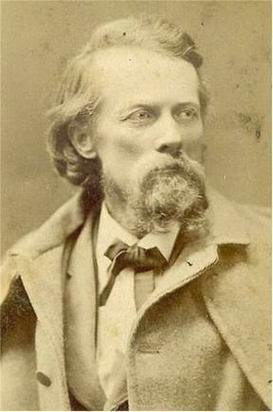Louis E Volker
Sons of Union Veterans of the Civil War


Louisa E. Volker & Captain Thomas Hanlon Macklind Louisa E. Volker was born in St. Louis, Missouri, in 1838, the daughter of, Emanuel and Emily (or Amelia) Volker. Around 1860, her family relocated from St. Louis to Mineral Point. Louisa, now aged 22, is still shown as living with her parents.
Mineral Point was an important junction for the St. Louis and Iron Mountain Railroad, which had been built south from St. Louis to Pilot Knob, Missouri. Around the beginning of 1863, Miss Volker became a member of the U.S. Military Telegraph Corps. About seven months previous, Miss Volker had relieved C. T. Barrett, operator at Mineral Point, and became at once the first lady operator in the Corps, west of the Mississippi.
On a former occasion, the station six miles north of the Point was attacked by cavalry, surprising Captain Lippencott's Company, which being driven off, collected at Mineral Point. Miss Volker had previously ascertained the presence of the enemy, telegraphed to Pilot Knob the situation, and started the repairer north to mend the line. She sat by the instrument all night in expectation of an attack on Mineral Point.
Later, September 19, 1864, Confederate Major General Sterling Price crossed over from Arkansas into Missouri at the head of a force of 12,000 -15,000 men. This would later be known as Price’s Raid. Union forces under the command of Major General A.J. Smith were encamped in the area of Mineral Point. Smith's command was concentrated to meet a portion of Price's troops expected there, and called in his out-posts, awaiting attack. A train laden with soldiers and refugees, including the Irondale operator, was delayed in consequence of injury done. The attack on the train which followed was repulsed, the track repaired, and the train saved. By this time the woods were filled with Confederates, and picket firing began. Miss Volker, operating at the Point, having been at her instrument continuously for two days and nights, was relieved by the Irondale operator.
General Price soon made Fort Davidson, near Pilot Knob, his main target; and began to destroy the rail and telegraph links to St. Louis. General Joseph Shelby was sent to accomplish this; by the morning of September 27, Shelby had succeeded in destroying the railroad tracks just south of Mineral Point, and in cutting the telegraph wires. General Smith had been ordered to fall back toward St. Louis. Miss Volker and sister remained to protect their father's home from destruction. After hiding all evidences of her employment, she placed a pistol in her pocket, fixed on defending herself and sister. As they overlooked the little village from her window, and discovered Confederate cavalrymen, the depot, tank, and engine-house were in flames. Mineral Point and Coles bridges also were destroyed. A short time later the Confederate forces moved on, with Volker and her sister unharmed. Little is known of her telegraphy career from thence forward.
During the war, Louisa Volker made the acquaintance of Thomas Hanlon Macklind, a lawyer and civil engineer in Potosi, Missouri. He moved to Missouri in 1856, and participated in the construction of the St. Louis and Iron Mountain Railroad. In Potosi, he studied law, and was admitted to the bar in 1860 and by 1861, he and several other pro-Union men of Potosi organized a volunteer unit, the 12th Missouri Cavalry - Missouri State Militia. Macklind was promoted from Second Lieutenant to Captain. In May 1865, Captain Macklind and Louisa Volker were married in St. Louis, soon moving there and Macklind became an engineer with the Street Department (whom Macklind Avenue is still named for). They had two sons, William R, born in 1869, and Thomas V., born in 1880.
Louisa Macklind evidently gave up telegraphy after her marriage; however, she took an interest in a field that was just beginning to be open to women in the 1870s – stenography. She not only learned stenography, but also gave free instruction to poor girls of the city. Then, in 1895, at age 58, she graduated from Women's Medical College in St. Louis, and was granted license #6720 for regular practice medicine. On May 18, 1895, she was listed in the State Board of Health’s Register of Physicians; although, she never practiced extensively and most of her practice was devoted to charity cases. Louisa Macklind died on May 21, 1905. Her obituary appeared in the May 22nd St. Louis Post Dispatch under the heading, “First Woman War Telegrapher Dead.” Cause of death was listed as senile debility, aggravated by ulcers. She was buried in Bellefontaine Cemetery, in the same plot with her husband and parents.
The only surviving written account of her work as a Military Telegrapher appears in “The Military Telegraph During the Civil War in the United States", Volume I by William Rattle Plum, 1882. The Louisa Volker Auxiliary #215, Auxiliary to the Sons of Union Veterans of the Civil War (ASUVCW) of Park Hills, Missouri, was named in her honor, with her story being reasearched by Twyla Dawn Johnson Warren.
Photographs and information submitted by D. Christopher Warren, Missouri Department Commander, SUVCW and Twyla Dawn Johnson Warren, PAP, Secretary-Treasurer, Louisa Volker Auxiliary #215, ASUVCW.

Louisa E. Volker & Captain Thomas Hanlon Macklind


